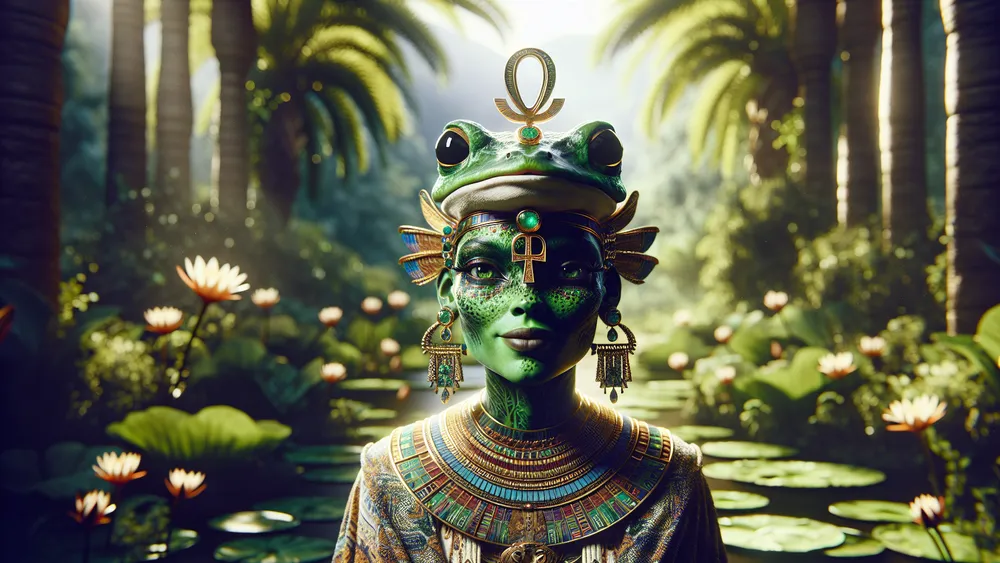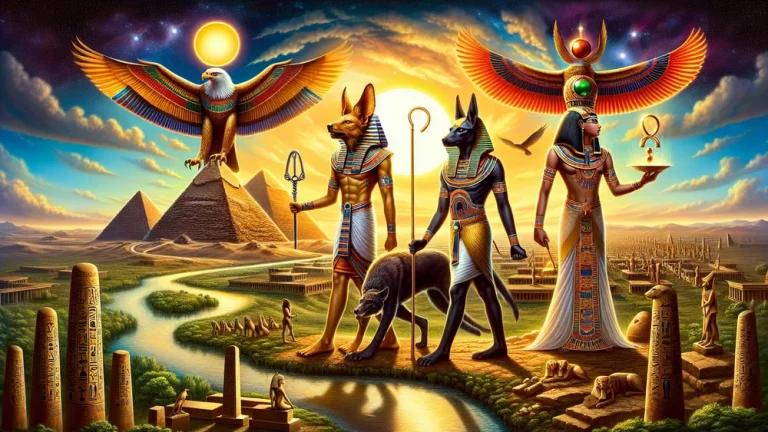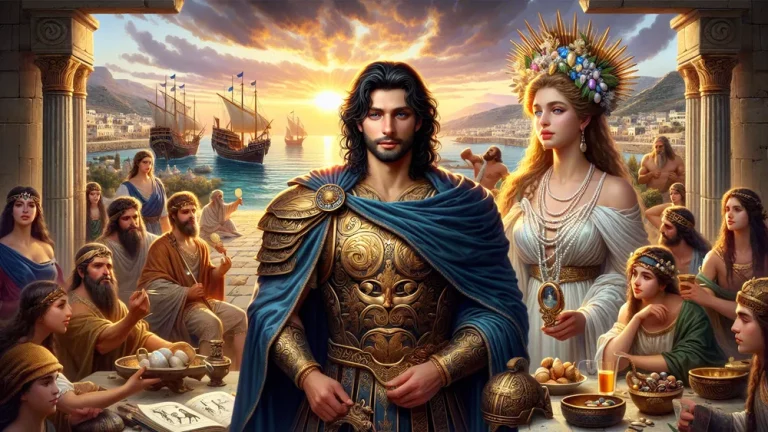Heket: Egyptian Goddess Of Fertility And Rebirth
Heket, the ancient Egyptian goddess of fertility and rebirth, is a fascinating figure. She’s not just a deity; she’s a symbol of life and renewal. People in ancient Egypt really looked up to her. They saw her influence everywhere – from religion and mythology to medicine and everyday life. You often see her depicted as a frog or a woman with a frog’s head. Why?
Key Points:
- Heket is the Egyptian goddess of fertility and rebirth.
- She is symbolized by a frog and is linked to water and fertility.
- Heket plays a key role in Egyptian religion as the goddess of childbirth and fertility.
- In ancient Egyptian culture, Heket’s symbols include the frog and water.
- Heket is also influential in Egyptian medicine and magic, especially in childbirth.
- Modern neopagan and Wiccian groups often invoke Heket for fertility and rebirth rituals.
- Heket’s story and influence extend to contemporary culture and art.
Because she’s believed to help create life and ensure safe childbirth. This blog post dives into her story, exploring her origins, roles, and lasting impact. We’re going to see why she’s so important in ancient Egyptian society and why she still matters today. Ready to learn more? Let’s jump in!
The Origins of Heket
So, where does Heket come from? To get the full picture, we need to dive into her story and see how she fits into ancient Egyptian mythology. Ready to explore? Let’s go!
Historical Background and Mythological Roots
Heket pops up in ancient Egyptian texts as far back as the Old Kingdom (around 2686–2181 BCE). She’s a big deal in creation myths, especially those involving the Ogdoad of Hermopolis. This group of eight deities represents the basic elements of creation. Heket is all about water and fertility, playing a key role in bringing life into the world.
You often see her in ancient Egyptian art and hieroglyphs as a frog or a woman with a frog’s head. Frogs symbolize fertility and renewal because they’re always around water and have lots of babies. Key points about Heket’s depiction:
- Often shown as a frog or a woman with a frog’s head.
- Linked to water and fertility.
- Commonly appears in amulets and statues for protection and good fortune.
Heket, a prominent figure in ancient Egyptian mythology, is closely tied to water and fertility, often represented as a frog or a woman with a frog’s head, and frequently featured in art and hieroglyphs for protection and good luck.
Heket’s Role in Egyptian Religion
Alright, so we’ve got a handle on Heket’s origins. Now, let’s jump into how she fits into Egyptian religion. How did people worship her, and what roles did she play?
Goddess of Fertility and Childbirth
Heket plays a big role in ancient Egyptian religion as the goddess of fertility and childbirth. She’s all about helping bring new life into the world. Expectant mothers often turn to her for protection and help during labor. They perform special rituals and say prayers to get her blessings.

The frog, which is often linked to Heket, stands for fertility and rebirth because of its life cycle (from tadpole to adult frog) and its connection to water. This symbolism really highlights Heket’s role in making sure children are born safely and life keeps renewing. Key points about Heket’s association:
- Goddess of fertility and childbirth.
- Rituals and prayers by expectant mothers.
- Frog symbolizes fertility and rebirth.
Heket in the Egyptian Pantheon
Heket really stands out among the Egyptian gods and goddesses. She focuses on fertility and childbirth, which makes her special. While other deities have overlapping roles, Heket zeroes in on bringing new life into the world. She often teams up with Khnum (the god who shapes human children from clay on his potter’s wheel) and Osiris (the god of the afterlife and rebirth).
This teamwork shows how important she is in both creating and renewing life. You see Heket popping up in various rituals and ceremonies that celebrate life, birth, and regeneration.
| Deity | Role | Relationship with Heket |
|---|---|---|
| Khnum | God of creation and water | Works with Heket in shaping human children |
| Osiris | God of the afterlife and rebirth | Shares themes of rebirth and renewal with Heket |
| Isis | Goddess of magic and motherhood | Overlaps with Heket in aspects of childbirth and protection |
Heket’s unique focus on fertility and childbirth, distinct from other Egyptian deities, is highlighted through her collaboration with Khnum and Osiris in the creation and renewal of life.
Heket in Ancient Egyptian Culture
Alright, let’s jump into how Heket pops up in everyday life and culture in ancient Egypt. You see her influence everywhere, from symbols to medicine.
Heket in Egyptian Medicine and Magic
Heket plays a big role in ancient Egyptian medicine, especially when it comes to childbirth. People often call on her in magical spells and incantations for protection and healing. These spells aim to keep both the mother and baby safe during labor. You see Heket’s imagery a lot in medical papyri and magical texts. She’s usually shown as a frog or a woman with a frog’s head.

These images aren’t just for show; they’re there to tap into her protective and healing powers. Key aspects of Heket in medicine and magic:
- Role in childbirth: Keeps mother and baby safe.
- Magical spells and incantations: Used for protection and healing.
- Imagery in medical papyri and magical texts: Shows Heket as a frog or a woman with a frog’s head.
Heket’s Influence in Modern Times
Heket’s story doesn’t stop in ancient Egypt. She still inspires and influences people today.
Heket in Contemporary Culture
These days, Heket gets a lot of attention, especially from Neopagan and Wiccian groups. They often call on her during rituals for fertility and rebirth. You also see Heket popping up in modern media, literature, and art. She’s a symbol of life and transformation. Various books and artworks show her as a powerful figure tied to creation and renewal.
Plus, some modern festivals and events celebrate Heket. These gatherings focus on themes of fertility and new beginnings, with rituals and ceremonies that honor her ancient legacy.

Pantheon of All the Egyptian Mythology Gods
Want to dive into the world of Egyptian mythology? You can explore the stories and roles of other gods and goddesses. Just check out this list of all the Egyptian gods. It’s a fascinating read!
FAQs
1. Who is Heket in Egyptian mythology?
Heket in Egyptian mythology is the goddess of fertility, childbirth, and rebirth, often depicted as a frog or a woman with a frog’s head.
2. What symbols are associated with Heket?
Symbols associated with Heket include the frog and water, both representing fertility and rebirth.
3. How was Heket worshipped in ancient Egypt?
Heket was worshipped in ancient Egypt through rituals and prayers, particularly by expectant mothers seeking her blessings for a safe childbirth.
4. What is Heket’s role in modern neopagan practices?
Heket’s role in modern neopagan practices often involves invoking her as a symbol of fertility, rebirth, and protection during childbirth rituals.







